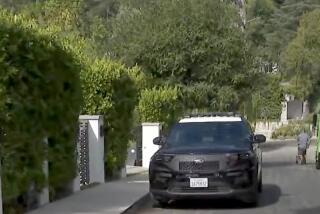Experts Urge Gang Watch in Affluent Areas
In the affluent, pastoral neighborhoods of Ventura County, gang members “tag” or display their hand signs, sport turf colors and speak the language of the streets.
The Houston Hoods in Thousand Oaks and Westlake, the Moorpark Party Boys and the Ventura Skinhead Dogs are known well by experts who study gang behavior or work in law enforcement.
But the people who live in those communities often deny that such groups exist outside the inner cities of Los Angeles, experts said at a seminar in Thousand Oaks on Saturday.
“These gangs are coming up,” Milton (Robbie) Robinson, a deputy probation officer for Los Angeles County, told about 40 people at Charter Hospital of Thousand Oaks. “It’s prime area. It’s virgin territory. It’s easy to intimidate.”
The daylong seminar was sponsored by Soroptimist International of the Conejo to educate teachers, therapists, parents and community members to the warning signs of gang behavior.
Families with money are not immune to losing their children to the gang culture, Robinson said, because wealthy teen-agers also crave attention, respect and excitement. And gang members from Los Angeles can easily prey on those people to expand their turf or drug business, he said.
Robinson urged his audience to learn the culture to be able to fight it. “We should become our own gang,” he said.
A native of Washington, D.C., and a probation officer on gang detail for 10 years, Robinson said he speaks the language of the streets to better understand the teen-agers he works with.
“When you confront them and talk the same language as they do, they respect you,” he said. He pointed out the warning signals of a person’s dress, such as sagging pants, baseball hats, hair nets and white T-shirts.
“Once you know what you’re fighting with then you can be better equipped,” he said. “It is based on turf and belonging. . . . This is the family for these kids.”
Throughout the seminar, audience members signed up with Crime Stoppers of Thousand Oaks or “Youth at Risk,” a program in which volunteers take gang members camping.
The Conejo Valley and the county need to head off the problem before it grows larger, rather than just waiting for drive-by shootings, said Tom Kratochvil, a probation officer at a juvenile detention center in Calabasas.
Some audience members criticized the low turnout at the conference. “We’re too apathetic,” said Pat Yendes, who sits on the board of Crime Stoppers in Thousand Oaks. “We’re assuming we can leave our doors unlocked.”
“It’s not just apathy,” said Bobby Knapp, athletic coordinator for Westlake High School. “They really don’t believe” that gangs exist in this county. An employee at the school for eight years, Knapp said she has seen new students enter the Thousand Oaks school as gang members and almost immediately earn the respect and admiration of their peers.
“Intimidation is really easy out here,” she said.
George-Anne Pollack, who owns an interior decorating business in Thousand Oaks, said she used to teach in rough areas of Philadelphia but never encountered the violence that she associates now with gang members in her neighborhood.
“I look back on the students I had then. They were babes compared to what we have here in an upper-middle-class community,” she said. “I don’t think we take it seriously enough here.”
Pollack said many in the community dismiss the teen-agers as “wanna-bes,” students just mimicking gang members.
But Robinson said, “When they say ‘wanna-bes,’ they’re saying ‘There’s no damage here.’ ”
More to Read
Sign up for Essential California
The most important California stories and recommendations in your inbox every morning.
You may occasionally receive promotional content from the Los Angeles Times.










